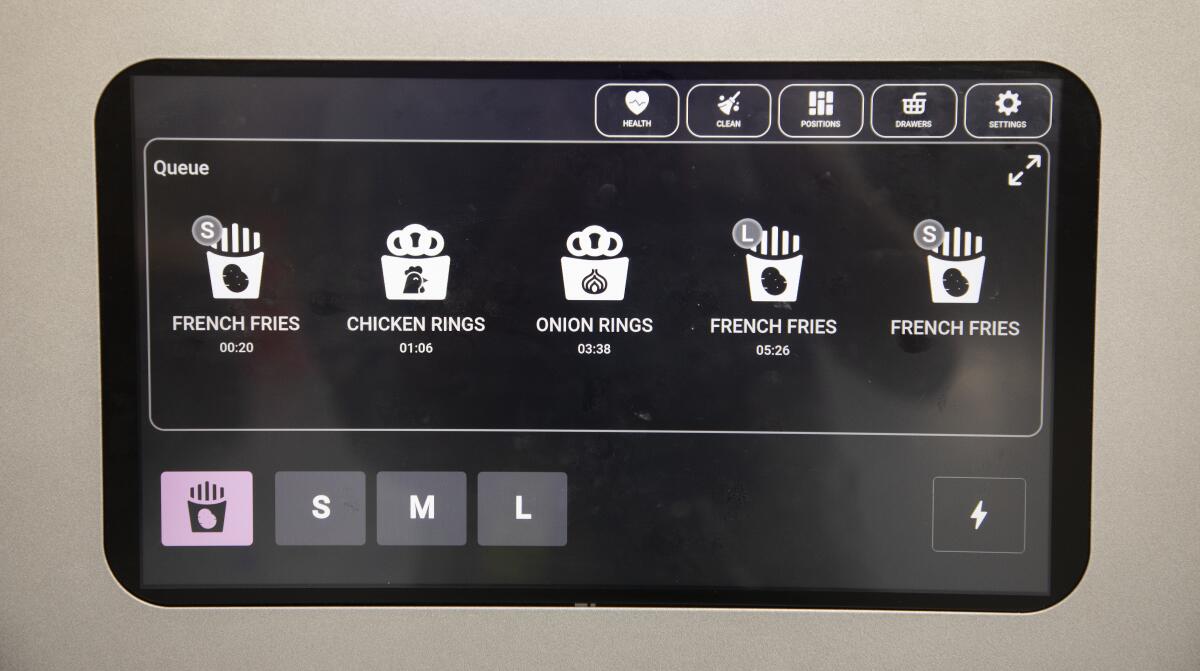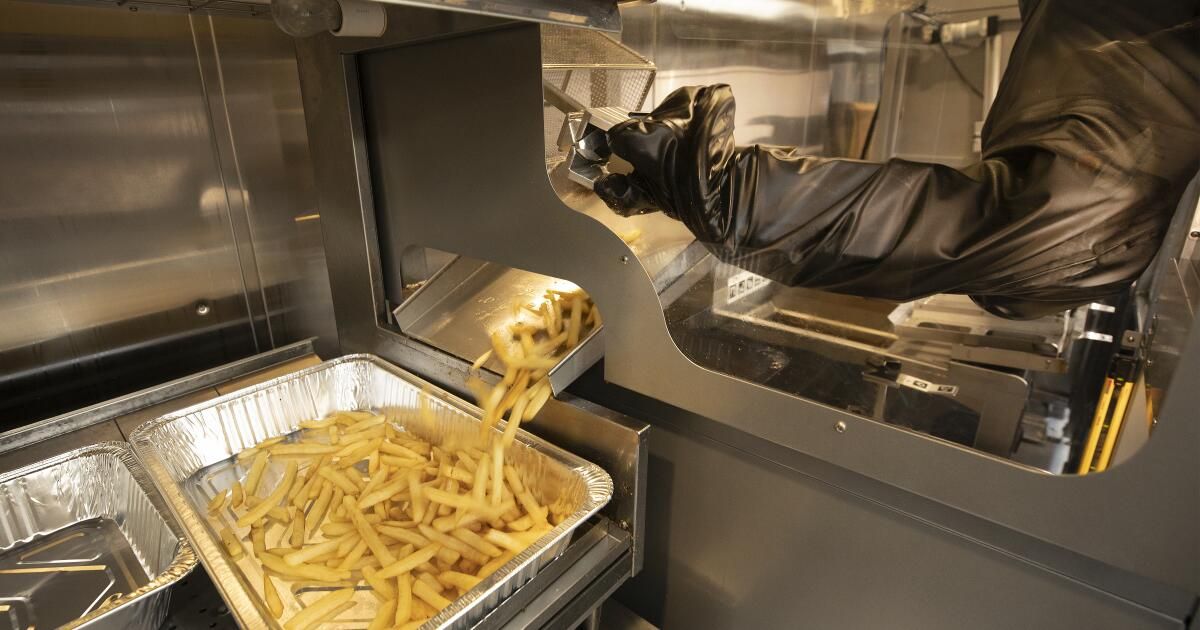The Miso Robotics lab in downtown Pasadena is filled with robots from the past and present.
There's Sippy, Chippy and Drippy. The star of the lab: an updated robot called Flippy that can fry French fries and chicken nuggets much faster than humans.
Miso Robotics has a lot riding on its ability to convince fast-food chains to incorporate Flippy, a robotic arm that drops fryer baskets into hot oil, into their kitchens. With the restaurant industry hit by higher costs driven in part by rising minimum wages in California and other states, Miso is one of several tech startups betting that more businesses will look for new ways to save money, reduce employee turnover and meet more orders.
“You're never going to get rid of humans in restaurants, nor would you want to,” said Miso Robotics CEO Rich Hull. “What you're trying to do is automate tasks that humans don't like to do.” Flippy can process more than 100 fry baskets per hour, noticeably faster than the roughly 70 baskets the company estimates employees can handle during the same period of time. The robot also prevents workers from being burned by hot oil or slipping on grease.
Flippy, the robot that makes French fries at Miso Robotics
Restaurant chains have been experimenting with robots in the kitchen for years. But while several companies, including White Castle, Sweetgreen and Chipotle, are testing ways to automate food preparation, circuits and software haven't yet taken over.
“We are at a very, very early stage. The return on investment has not been proven,” said John Gordon, a restaurant industry analyst who founded Pacific Management Consulting Group. “There is certainly an opportunity in some restaurants because of the…repetitive work that is done” out of sight of diners.
For some companies, the first results are promising. Los Angeles-based fast-casual restaurant Sweetgreen has been testing what the company calls its “Infinite Kitchen,” which uses machines to dispense and mix salad ingredients that humans then put the finishing touches on. Two locations that piloted the technology, including one in Huntington Beach, saw improvements in order accuracy and employee turnover, while average sales were 10% higher, executives said during a recent earnings call. .
Miso Robotics, founded in 2016, has tested previous versions of Flippy at about 20 restaurants, including White Castle, CaliBurger and Jack in the Box. White Castle, a burger chain with locations primarily in the Midwest and the region around New York City, said it hopes to move forward with plans announced last year to roll out Flippy to nearly a third of its roughly 350 restaurants.

Rich Hull, CEO of Miso Robotics, shows off the latest version of Flippy at the company's lab in Pasadena.
(Al Seib / For The Times)
The field of fast food robotics is littered with companies that failed in their attempts to revolutionize the restaurant industry. Last year, Zume, a Silicon Valley pizza-making startup, closed after raising $450 million from SoftBank's Vision Fund and other investors. Among other problems, the company, founded in 2015, reportedly had trouble getting its robots to prevent melted cheese from falling off pizzas being baked in a moving truck on their way to customers. And in 2022, food delivery company DoorDash shut down Chowbotics, the company behind a robotic salad vending machine, about 18 months after purchasing the startup because it failed to live up to expectations.
Miso Robotics appears to be at a turning point, analysts said. As of June 2024, the startup had an accumulated deficit of $122.8 million and meager cash reserves of just under $4 million. The company's negative operating cash flows have raised concerns about its ability to survive, a report filed with the U.S. Securities and Exchange Commission, it says.
Hull and other executives started last year, and former CEO Michael Bell was fired in May 2023, another presentation sample.
As of March, the company had raised $126.5 million from investors and was in the process of raising additional funds, according to Pitchbook data. Gordon and other analysts said they believe the company's immediate future depends largely on its ability to raise more cash while trying to increase sales.
Hull, an early investor in Miso Robotics, is a Hollywood film producer and executive who also founded a Spanish-language streaming company, Pongalo, which was later renamed Vix. TelevisaUnivision acquired Vix Inc. in 2021. He said Miso's board of directors and Ecolab, which invested $15 million in the company, led him to grow the startup much like he did with the streaming business.
“Innovation is not easy. It's really difficult. “Now we have a seven-year head start on everyone else, but it’s tough,” Hull said. “I love disorder. “That’s always been my thing.”
He said the company recently closed a $20 million financing round.
The company plans to significantly increase its production capabilities next year, allowing it to fulfill any orders it receives, Hull said, adding that Miso aims to be profitable by the end of 2026.
Some labor analysts wonder if automation will help the workers. Brian Justie, a senior research analyst at the UCLA Labor Center, visited a restaurant that was using Flippy over the summer.
“Whether it's faster or cheaper than a … traditional restaurant, I think what was very clear was that there were fewer people doing virtually the same amount of work or more work with a limited menu,” he said.
During a demonstration at the Miso Robotics lab, Hull highlighted improvements the company has made to Flippy, including making it smaller so it can fit under the range hood and on top of fryers in a compact kitchen. And he said the integration of artificial intelligence technology has reduced food waste and improved durability, as the machine is able to troubleshoot problems with its operating system or alert a customer service representative if it's about to go out. break down.
Miso Robotics has tested other robots, which were intended to serve self-service drinks (Sippy) or cook and season tortilla chips (Chippy), but Hull said its engineers are focusing for now on the fryer robot. Miso initially designed Flippy to flip burgers when the startup introduced the robot in 2017, but the company changed course when it saw a greater revenue opportunity with fried foods, he said.
Miso executives believe frying technology could be a boon to the company, stating in a government document that “Flippy's frying station automation represents a potentially massive $3.5 billion revenue opportunity for Miso alone.” in a market that, more importantly, still remains fragmented. underdeveloped, undercapitalized and full of growth opportunities for a company with Miso's first-mover advantage.”
Restaurants can buy or rent the robot and the company also makes money from maintenance, software updates and technical support. Most customers rent Flippy for between $5,000 and $6,000 a month, but several factors can influence the price, including the number of fryers in a restaurant.
Several chains, including Panera, Jack in the Box, Chipotle and Buffalo Wild Wings, have been testing Miso's technology since 2021, SEC filings show. Many of the companies declined to detail whether the robots generated cost savings, but pointed to other benefits.
At White Castle, for example, Flippy robots have allowed employees to better focus on other aspects that improve customer experiences, such as order accuracy and hospitality, said Jamie Richardson, the chain's vice president of marketing and public relations. .

A touch screen allows a worker to operate Flippy's robotic arm.
(Al Seib / For The Times)
The burger chain turned to Miso after realizing that workers assigned to the fast food and fry station were having to juggle multiple responsibilities and orders. White Castle also partnered with SoundHound to test an AI voice assistant called Julia (named after a beloved White Castle hostess named Julia Joyce from the 1930s) to help take self-service orders. In June, McDonald's announced it would end a similar pilot program with IBM amid reports that the technology had struggled with people's accents.
With many variables at play, White Castle has not measured whether Flippy has improved employee retention, Richardson said. So far, employees have received positive feedback about the robot.
“People who come to us want hot, tasty, affordable food,” he said. “If you can eliminate the weak points of that, if you can reduce the friction, everyone wins.”
Curt Garner, Chipotle's chief customer and technology officer, said the restaurant chain tested the Miso tortilla chip-making robot at an Orange County location between 2021 and 2023. Although the pilot ended last year, Garner said the restaurant incorporated what it learned into other products.
For the record:
6:28 pm October 30, 2024A previous version of this story incorrectly stated that James Jordan is president and chairman of the board of directors of Miso Robotics. He no longer plays those roles.
Chipotle, which has a $100 million venture fund, has invested in other startups, including Vebu Labs, which was founded by former Miso Robotics president and chairman James Jordan. The partnership produced Autocado, which cuts, cores and peels avocados before workers mash them by hand to create guacamole. It has also invested in San Jose-based Hyphen to create what the company calls an “augmented production line” that uses automated technology to create bowls and salads while Chipotle employees prepare burritos, tacos, quesadillas and kids' meals. .
Jot Condie, president and CEO of the California Restaurant Assn., said the COVID-19 pandemic fueled increased interest in the use of automation and technology in restaurants.
Much of the adoption, he anticipates, will occur in fast-casual restaurants where convenience and efficiency are key, rather than in full-service restaurants where interaction with friendly servers is a more important part of the experience.
“Quick-service restaurants like Chipotle, which have the ability and resources to invest and adopt technologies, will sort of lead the way,” he said.












